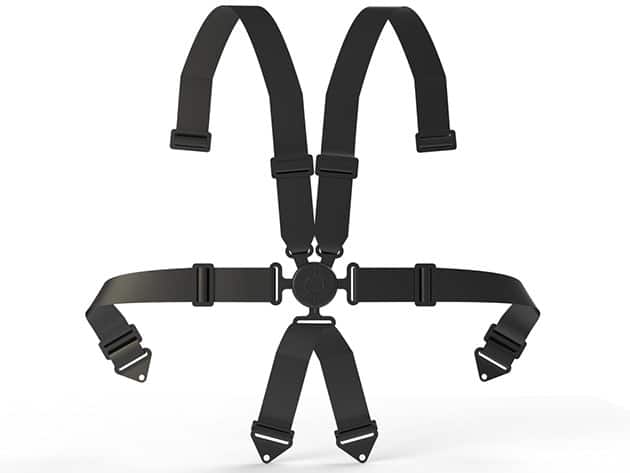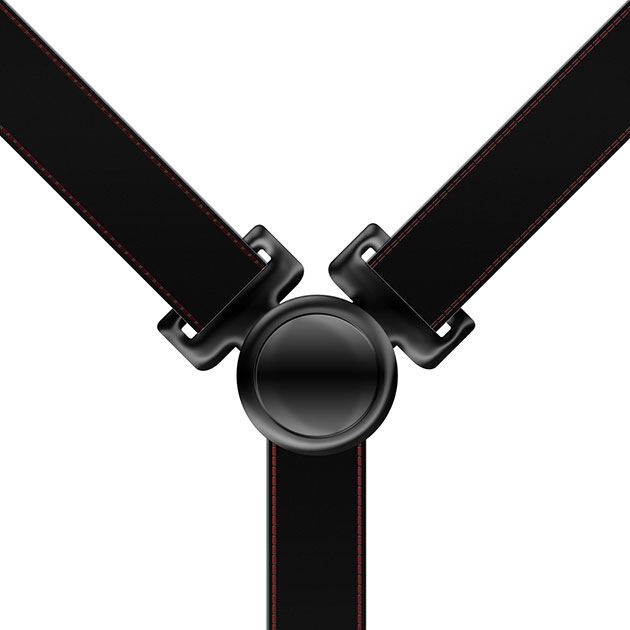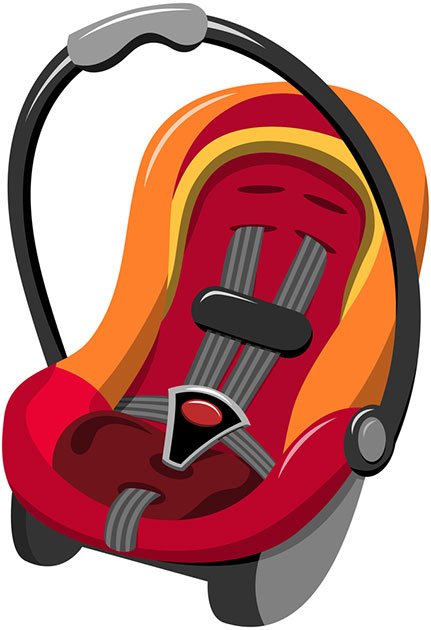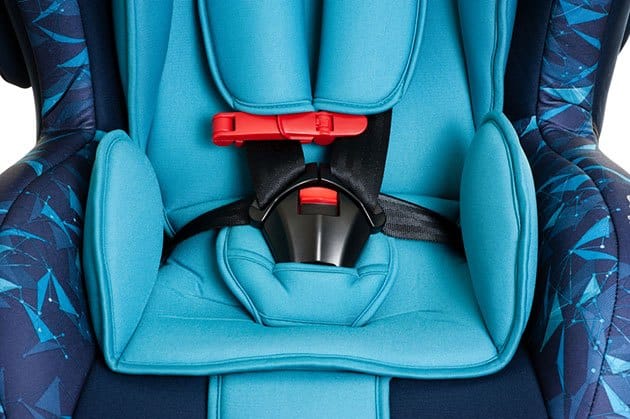A child's car seat is equipped with a harness that protects the child's body at all critical points.
However, many first-time parents are baffled with choosing a 5 point vs 3 point harness car seat.
This guide reviews the 5-point harness car seat compared to a 3-point harness car seat while choosing the best option for the child's age, stage, and safety.
More...
What is a 5-point Harness?

A 5-point harness restrains the child's body while offering support to the child's shoulders and hips. The two attachment points ensure the child sits correctly in the rear-facing or forward-facing harnessed seat.
A five-point harness is designed after a racing-style harness. With the racing-style design, the harness is created to minimize the ejection risk of crash forces. In addition, the support for the child's hips and shoulders allows for a tight fit and holds the child's body close to the car seat.
The crash energy is distributed across the child's torso, compared to a safety belt that offers less adequate support for smaller children.
Both rear-facing and forward-facing car seats include a five-point harness for maximum protection for very young children under 40 pounds.
- Minimized risk of ejection
- Helps the child sit properly in a car seat throughout the entire ride
- Disperses the crash force across the large area of the body
- Includes a top tether for the proper position of the head
- The harness has height and weight limits.
- Complicated installation process
- The harness might cause strain on the neck, especially for older kids.
Who needs a five-point harness seat?
Children weighing under 40 pounds should be restrained with a five-point harness. Forward-facing car seats with five-point harnesses provide adequate support to children who are not yet ready to sit correctly in a three-point harness seat.
Five-point harness car seats are safer for younger children under five. You mustn't prematurely transition a child to a three-point car seat or a booster, especially if a child is below the weight or height limits.
It's best to continue using a five-point harness until the child outgrows it completely.
How to properly wear a 5-point harness?
1. Adjust the shoulder straps
Child car seats have adjustable harness straps. Begin by adjusting the shoulder straps when placing a child in a car seat. Some car seats require you to reread the shoulder strap, while others have a non-threadable harness.
A no-rethread harness on a forward-facing car seat will make it easier to adjust the straps as the child grows.
The shoulder harness strap must be above the child's shoulder when forward-facing.
2. Tighten the harness
The next step is tightening it once it is adjusted. Do the pinch test to check for excess webbing fabric on the harness.
Most car seats have a webbing tail so the car seat harness can be installed correctly. Pull the webbing tail and tighten the straps. Next, slide the chest clip to the armpit level.
3. Crotch & hip buckle
Read the manual instructions on properly adjusting the crotch and hip buckle. Some car manufacturers have different systems of adjustments.
What is a 3-point Harness?

A three-point harness has fewer support points and resembles a traditional seat belt. With the three-point harness design, a child is secured with a shoulder belt and a lap belt. In addition, high-back booster seats are equipped with a three-point harness, ensuring the child's safety.
Unlike a five-point harness, a three-point harness does not have additional hip straps that keep the child in the optimal position. For the lack of support, a three-point harness is reserved for older children between the ages of 6-12.
Despite the fewer points of restraint, a three-point harnessed seat is much more comfortable, especially for older kids. Not much pressure is put on the spine and the neck.
The looser design will allow kids to lean sideways and forward.
The harness with three attachment points does not help kids sit correctly in the seat, which is why it's important to ensure a child's maturity before transitioning to a booster seat.
- No risk of getting loose as seat belts retract on their own
- No weight limit
- Straightforward installation process
- The vehicle’s seat belt is much more comfortable.
- Most kids enjoy a high-back booster for longer trips.
- Fewer restraint points
- Does not restrict the child from leaning forward
- Easier for the child to get out of the harnessed car seat
- Not suitable for younger kids
Who needs a three-point harnessed car seat?
A three-point harnessed car seat is suitable for children who weigh more than 40 pounds, have exceeded the weight limit of a 5-point harness, and can sit properly in their car seat.
Before the booster seat transition, a child must fit within the requirements of a five-step test:
- A shoulder belt should lay flat on the shoulder, not close to the neck.
- The child's lower back needs to be against the booster seat.
- The lap belt goes over the upper thighs and across the hip.
- The child can ride in the booster seat without squirming or playing with the harness.
- A child should keep their knees bent at the end of the booster seat.
How to properly wear a 3-point harness?
Kids must be properly restrained with a 3-point harness when using a booster seat. Otherwise, the harness will not perform optimally should a crash occur.
Most booster seats have belt guides that allow you to reach the perfect height fit for the seat belt. The vehicle shoulder belt should be placed across the child's body, lying flat on the shoulders. The lap belt should sit across the upper thighs and over the hip.
3 point Harness vs 5 point Harness: Safety Differences

The restraining points are the biggest difference between a 3-point and 5-point harness. While a five-point harness supports kids at the hip, shoulders, and chest area, a three-point harness lacks hip support.
With a three-point belt, a child risks bending over the restraint at the abdomen in case of an accident. Such forward movement during a crash could develop internal injuries, especially if the child is not sitting properly.
Both harness car seats are safe if installed properly and used according to the child's age, weight, and height limit.
FAQs
How long should a child be in a 5-point harness car seat?
A child should be in a 5-point harness until weighing at least 40 pounds and can sit in a booster seat correctly. Between the ages of 5-9, children outgrow the 5-point harness system and are ready for a 3-point harness instead.
When should I switch my child to a 5-point harness?
Transitioning from a child to a 5-point harness should occur once the child exceeds the weight and height limit of the harness. Children up to 40 pounds of weight should remain in a 5-point harness, as it's considered the safest restraining method for younger children.
Why is a 5-point harness safer?
A 5-point harness is safer because it has more attachment points to protect the body in critical areas. Thanks to the five-point harness, the child's body is supported in the chest, shoulders, crotch, and hip area, while crash energy is distributed across the larger body area.
How long should a child be in a 3-point harness?
A child should stay in a 3-point harness car seat for as long as he meets the weight and height requirements. Many car seats with three-point harnesses are designed to support children up to 65 pounds.
Make sure your kiddo is mature enough to ride in a back seat booster with a vehicle seat belt before transitioning from a 3-point harness.

Is a five-point harness safer than a booster seat?
A five-point harness is safer than a booster seat for kids who don't weigh 40 pounds or are ready to ride in a belt-positioning booster.
The five-point harness has five attachment points compared to a vehicle seat belt with only two. A five-point harness will distribute the crash energy evenly during a crash while keeping the child adequately positioned.
It's necessary to follow the car seat manufacturers as well as NHTSA recommendations
before transitioning to a booster seat.
Final Words
A five-point harness is a safer option for younger children, gathered from all the pros and cons. In addition, with the additional two attachment points, parents can be at ease regarding their child's safety.
The five-point harness seat is necessary for a young age, but as soon as your kiddo outgrows it, it's time to switch to a three-point harness.
The range of movement of a three-point harness seat will offer children the independence they need and prepare them for their first backless booster ride in the future!
